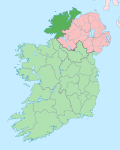Inver Inbhear | |
|---|---|
Village | |
 Inver and Inver Beach | |
| Coordinates: 54°39′36″N8°17′56″W / 54.66°N 8.299°W | |
| Country | Ireland |
| Province | Ulster |
| County | County Donegal |
| Time zone | UTC+0 (WET) |
| • Summer (DST) | UTC-1 (IST (WEST)) |
Inver (Irish : Inbhear, meaning 'estuary') [1] is a small village in County Donegal, Ireland. It lies on the N56 National secondary road midway between Donegal town to the east and Killybegs to the west. Inver is also a civil parish in the historic barony of Banagh. [2] [3]



